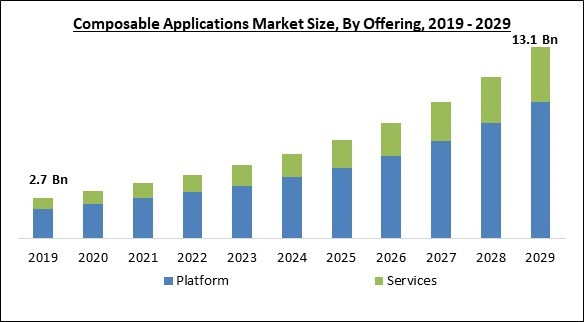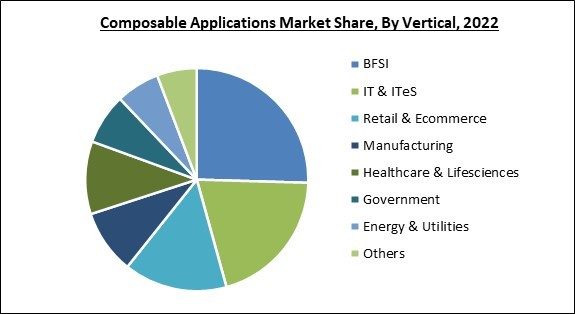The Global Composable Applications Market size is expected to reach $13.1 billion by 2029, rising at a market growth of 17.4% CAGR during the forecast period.
BFSI is the major end user of composable applications as banks and other financial institutions rely on composable infrastructure solutions to safeguard their data against cybercrime. Thereby, BFSI is expected to contribute approximately 1/5threvenue share of the market by 2029. These institutions are widely deploying platforms that enable event-driven architectures, greatly encouraging businesses to use composable applications, making platforms a leading category by generating $3,131.2 million revenue in 2022. Some of the factors impacting the market are Rising digitalization across the IT industry, Growing need for app development and Difficulties faced while using composable applications.
Composable applications can provide the necessary assistance via an interdependent system in a "digital transformation" process, which can be regarded as a modern approach to corporate processes. Hence, it is anticipated that due to the accelerated digital transformation, the usage of composable applications will increase in the years to come, boosting market expansion. The volume of applications has increased dramatically in recent times. Over half of small-to-medium-sized SaaS businesses ought to employ integrated business capability architecture to outperform their competitors. As a result, market growth is anticipated in the next years.
However, for composable applications to deliver on their promises, careful planning, design, development, and administration are necessary. An architectural software strategy that involves disassembling a program into smaller, independent building pieces or services is required for composable applications. Thus, the difficulties faced while using composable applications may restrict their adoption and hamper the market's expansion.
The market research report covers the analysis of key stake holders of the market. Key companies profiled in the report include Salesforce, Inc., Informatica, LLC, Software AG, Nutanix, Inc., Juniper Networks, Inc., Lenovo Group Limited, Western Digital Corporation, Hewlett-Packard Enterprise Company, NetApp, Inc. and Dell Technologies, Inc.
BFSI is the major end user of composable applications as banks and other financial institutions rely on composable infrastructure solutions to safeguard their data against cybercrime. Thereby, BFSI is expected to contribute approximately 1/5threvenue share of the market by 2029. These institutions are widely deploying platforms that enable event-driven architectures, greatly encouraging businesses to use composable applications, making platforms a leading category by generating $3,131.2 million revenue in 2022. Some of the factors impacting the market are Rising digitalization across the IT industry, Growing need for app development and Difficulties faced while using composable applications.
Composable applications can provide the necessary assistance via an interdependent system in a "digital transformation" process, which can be regarded as a modern approach to corporate processes. Hence, it is anticipated that due to the accelerated digital transformation, the usage of composable applications will increase in the years to come, boosting market expansion. The volume of applications has increased dramatically in recent times. Over half of small-to-medium-sized SaaS businesses ought to employ integrated business capability architecture to outperform their competitors. As a result, market growth is anticipated in the next years.
However, for composable applications to deliver on their promises, careful planning, design, development, and administration are necessary. An architectural software strategy that involves disassembling a program into smaller, independent building pieces or services is required for composable applications. Thus, the difficulties faced while using composable applications may restrict their adoption and hamper the market's expansion.
Vertical Outlook
Based on vertical, the market is fragmented into BFSI, retail & e-commerce, government, healthcare & life science, manufacturing, IT & ITes, energy & utilities, other verticals. The IT & ITes segment garnered a significant revenue share in the market in 2022. The current environment drives IT organizations to expedite their applications, data, and innovations. It has to manage traditional bare-metal and virtualized applications more effectively while also enabling composable applications with software-driven automation and a resource pool that can be tailored to meet particular requirements.Offering Outlook
By offering, the market is segmented into platform and services. In 2022, the platform segment held the highest revenue share in the market. The ability to connect apps and data sources is made possible by the iPaaS offered by many vendors. These platforms include functionality for event-driven architecture, lifecycle management, and API interaction. This comprises an API Proxy, an API Gateway, and an API Developer Portal..Regional Outlook
Region wise, the market is analyzed across North America, Europe, Asia Pacific and LAMEA. In 2022, the North America region led the market by generating the highest revenue share. The region's economy is established, and significant sums are invested in IT infrastructure. In terms of innovation & growth, North America has an advantage over the rest of the world due to large security suppliers in the region. The growth of popular technologies like big data, IoT, ML, AI, cloud computing, DevOps, and corporate mobility has also pushed users and businesses to adopt far more advanced and reliable application platform software and related services.The market research report covers the analysis of key stake holders of the market. Key companies profiled in the report include Salesforce, Inc., Informatica, LLC, Software AG, Nutanix, Inc., Juniper Networks, Inc., Lenovo Group Limited, Western Digital Corporation, Hewlett-Packard Enterprise Company, NetApp, Inc. and Dell Technologies, Inc.
Scope of the Study
By Offering
- Platform
- Services
By Vertical
- BFSI
- IT & ITeS
- Retail & Ecommerce
- Manufacturing
- Healthcare & Lifesciences
- Government
- Energy & Utilities
- Others
By Geography
- North America
- US
- Canada
- Mexico
- Rest of North America
- Europe
- Germany
- UK
- France
- Russia
- Spain
- Italy
- Rest of Europe
- Asia Pacific
- China
- Japan
- India
- South Korea
- Singapore
- Malaysia
- Rest of Asia Pacific
- LAMEA
- Brazil
- Argentina
- UAE
- Saudi Arabia
- South Africa
- Nigeria
- Rest of LAMEA
Key Market Players
List of Companies Profiled in the Report:
- Salesforce, Inc.
- Informatica, LLC
- Software AG
- Nutanix, Inc.
- Juniper Networks, Inc.
- Lenovo Group Limited
- Western Digital Corporation
- Hewlett-Packard Enterprise Company
- NetApp, Inc.
- Dell Technologies, Inc.
Unique Offerings
- Exhaustive coverage
- The highest number of Market tables and figures
- Subscription-based model available
- Guaranteed best price
- Assured post sales research support with 10% customization free
Table of Contents
Chapter 1. Market Scope & Methodology
Chapter 2. Market Overview
Chapter 3. Global Composable Applications Market by Offering
Chapter 4. Global Composable Applications Market by Vertical
Chapter 5. Global Composable Applications Market by Region
Chapter 6. Company Profiles
Companies Mentioned
- Salesforce, Inc.
- Informatica, LLC
- Software AG
- Nutanix, Inc.
- Juniper Networks, Inc.
- Lenovo Group Limited
- Western Digital Corporation
- Hewlett-Packard Enterprise Company
- NetApp, Inc.
- Dell Technologies, Inc.
Methodology

LOADING...










